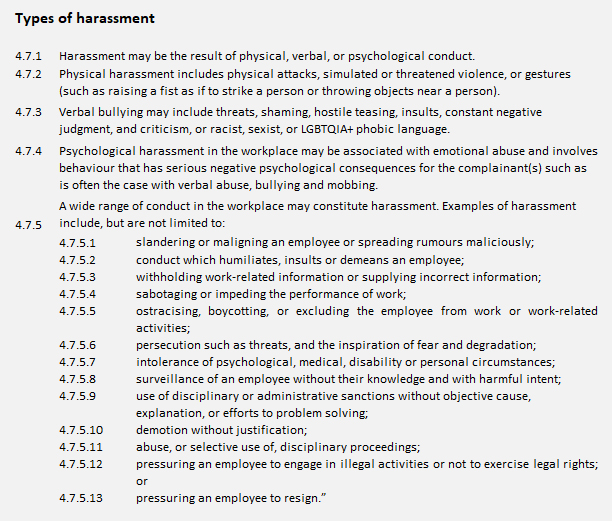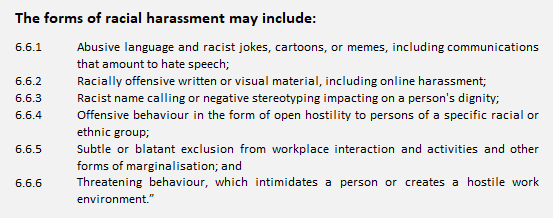“The criterion that harassment involves unwanted conduct distinguishes acts of harassment from acceptable conduct in the workplace” (extract from the Code, emphasis added)With effect from 18 March 2022, a new “Code of Good Practice on the Prevention and Elimination of Violence and Harassment in the Workplace” came into effect. Every employer and employee should know about it. The new Code has replaced the old “Code of Good Practice for the Handling of Sexual Harassment Cases in the Workplace”. It is much wider in every way possible because it “… is intended to address the prevention, elimination, and management of all forms of harassment that pervade the workplace” (extract from the Code, emphasis added). Of necessity, what is laid out below is no more than an overview of an extremely complex topic so in any doubt seek professional advice specific to your circumstances!
In a nutshell…
There’s a lot more detail below, but in essence –- The Code applies to all employers, employees, and workplaces (office-based or remote)
- Its reach is extremely wide in prohibiting any and all forms of workplace harassment
- Employers have a raft of duties to comply with in relation to assessing workplace risks of harassment, and in formulating and applying procedures to prevent and deal with it
- Failure to comply risks substantial liability.
Who does the Code apply to?
In a nutshell, it applies to pretty much everyone involved in any business with one or more employees, the Code making it clear to start with that all employers and employees, in both the formal and informal sectors, are included. Specifically mentioned as possible perpetrators and victims of harassment, in addition to employers and employees, are owners, managers, supervisors, job seekers and job applicants, persons in training including interns, apprentices and persons on learnerships, volunteers, clients and customers, suppliers, contractors, and (the very wide catch-all at the end) “others having dealings with a business”.When and where does it apply?
It applies virtually everywhere, including remote and out-of-office situations – “in any situation in which the employee is working, or which is related to their work”, including the workplace itself (widely defined), “work-related trips, travel, training, events, or social activities”, “work-related communications, including those enabled by information and communication technologies and internet based platforms”, employer provided accommodation and transport, and “in the case of employees who work virtually from their homes, or any place other than the employer’s premises, the location where they are working constitutes the workplace.”What must you as an employer do about it?
In broad terms you must –- Take proactive and remedial steps to prevent all forms of harassment in the workplace
- Conduct an assessment of the risk of harassment that employees are exposed to while performing their duties (emphasized as this is probably the best place to start!)
- Apply an attitude of zero tolerance towards harassment
- Create and maintain a working environment in which the dignity of employees is respected
- Create and maintain a climate in the workplace in which employees who raise complaints about harassment will not feel that their grievances are ignored or trivialized, or fear reprisals
- Adopt a harassment policy, which should take cognisance of and be guided by the provisions of the Code
- Develop clear procedures to deal with harassment, which should enable the resolution of problems in a gender sensitive, confidential, efficient, and effective manner.
What is “harassment”?
The following extract from the Code gives an idea of just how broad the general definitions of harassment are –
What is “sexual harassment”?
Again, the definitions here are extremely wide and include any form of unwanted conduct of a sexual nature including physical, verbal, or nonverbal conduct, whether expressed directly or indirectly. Specific examples that seem to have attracted the most media attention include sexual innuendos, comments with sexual overtones, sex related jokes, whistling of a sexual nature, sexually explicit texts, and “unwelcome gestures”, but there are many more.What about “racial, ethnic or social origin harassment”?
Again, the definitions are wide here, including the concept that “Racial harassment is unwanted conduct which can be persistent or a single incident that is harmful, demeaning, humiliating or creates a hostile or intimidating environment” and illustrated by this extract from the Code –
© LawDotNews
The post Workplace Harassment: The New Code in a Nutshell appeared first on KVV Inc.



















